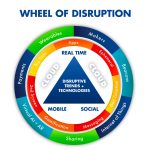Disruption at a Moments Notice
 In the world of tech, we recognize that introducing a new product or service is often highly disruptive to an existing market and its competitors. What is relatively new is the speed and scale in which that disruption can take place. The torrent of punditry that pre-empts these introductions is notable alone. It has created an unusually unsettled technology marketplace.
In the world of tech, we recognize that introducing a new product or service is often highly disruptive to an existing market and its competitors. What is relatively new is the speed and scale in which that disruption can take place. The torrent of punditry that pre-empts these introductions is notable alone. It has created an unusually unsettled technology marketplace.
The costs of sudden impact
In a hyper-connected world, the immediate reach and impact of the new provider can result in disproportional results from just incremental innovation–whether or not the solution even succeeds. It is the innovator’s dilemma in overdrive. This disruption at a moment’s notice largely eliminates the notion of a first-mover advantage. Flickr and Friendster can both vouch for that.
It would be easy to conclude that this disruption is a destructive force. Sure, there is something to be said for the uncertainty it can sow, and honestly it is impossible to know quite where it will take us. There is no doubt that organizations are being challenged in unprecedented ways and many consumers are riled by the constant volatility. I also have to believe that at some point every one of us has a capped quotient for fickleness.
At its core, the effect of disruption at a moment’s notice is an economic phenomenon. Clearly there is an important technical component, but introducing a new product or service that can have rapid and far reaching impact will shift existing market behavior — even if temporary in nature. In some instances, for publicly listed companies, the business introducing the technology may experience a bump in stock value and its competitors may see theirs experience downward pressure. Organizations too may wait for stability before making investments.
Let’s not be too hasty
When a new online service or app is introduced, pundits are quick to claim the imminent demise of its main competition. These existing organizations have worked hard over several years to earn, for example, each subscriber, friend, and follower. These analysts are often far too hasty and optimistic in their predictions. A sudden injection of viable competition is a great catalyst for innovation. It is one thing for customers to complain about existing functionality in the market leaders service, it’s quite another for that leader to respond to the potential existential threat from a new, disruptive competitor. Google makes Microsoft a better software company. Tesla makes Ford a better car company.
Understanding the implications
As an example, observing the speed of innovation currently in the cloud computing space reminds us that intense competition and the risk of sudden disruption is bringing innovative, low cost capability to buyers quickly. Take a look at online storage. It’s a moving target, but intense competition and innovation is forcing the cost down towards zero. Disruption is a compelling forcing function.
Currently we see dynamic and healthy competition in the domain of smartphones. But it is also a fragile battle. Now largely dominated by a small set of participants — solutions created by organizations with healthy balance sheets — innovation is alive and kicking. But should one stumble, a dominant player could emerge and we could see innovation atrophy. We don’t want that. Consumers are advocating for disruption; albeit, managed disruption.
Conversely, disruption is causing mainstream businesses to die overnight eliminating any notion of predictability and dislodging people and downstream processes along the way. Robots and artificial intelligence are making us nervous about how their advantages may shrink human participation in the labor market. And a nexus of emergent technologies and behavior is demanding that we think about privacy in completely new ways.
Advocating for disruptive innovation
As an IT leader I encourage rigorous, disruptive innovation and competition as it helps to keep product and service costs low and it can accelerate the introduction of desired functions and surprising new solutions. I also want this innovation to restrict the ability for large, domineering players to create a closed Web or to reduce the very freedoms that make it so empowering.
But with this level of innovation, I’m also concerned by the potential long-term costs and with user fatigue. Organizations and their staff are increasingly experiencing the chaos and downsides of frequent change management.
Disruption at a moment’s notice has the capacity to elicit considerable change in the way many organizations operate and compete. Nobody wants to be Kodak or Blockbuster, both of whom had time to change, but underestimated the disruption to their industries. Everyone wants to be Netflix, who moved in record time from mailing DVDs to streaming online to become a market leader.
Being ready and able to respond to market surprises should be a focus for every organization. Do you know where the next disruption may come from that impacts your industry? Who’s thinking about that in your organization?
What all this means for how organizations function and how consumers respond over the long-term has mostly yet to be determined. Fortunately, whether we act or not, we can rely on the marketplace to largely help sort out what happens next.

